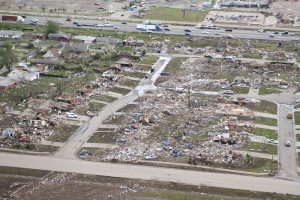 The dust is settling (due to the continual storms and rain) from the F5 tornado that once again ripped through South Oklahoma City and Moore. We have been devastated many times in Oklahoma due to tornadoes, but this was by far the worst.
The dust is settling (due to the continual storms and rain) from the F5 tornado that once again ripped through South Oklahoma City and Moore. We have been devastated many times in Oklahoma due to tornadoes, but this was by far the worst.
Over 13,000 homes are lost, thousands are damaged, 24 people lost their lives (10 of which were children), pets are still running loose trying to be collected for the transportation site at our local Home Depot, churches and other organizations are going over and above the call of duty to provide necessities, including counseling and shoulders to cry on.
But instead of focusing on what we have lost or what we need, like a true Oklahoman I want to focus on what we HAVE.
We have a community of volunteers from all walks of life from all over the state ( an many other states) that came running to help in our time of need.
We have firemen, policemen, nurses, EMSA workers, doctors and other medical personnel who ‘do what they are called to do’ no matter how miniscule the task may be.
We have neighbors and friends who do whatever needs to be done to help out each other.
We have community members who sit at the local donut shop and rehash all of the major catastrophes they have seen, and lived to tell, as a type of catharsis.
And we have teachers.
Two of Moore’s elementary schools were hit, one leveled, as a result of this catastrophe. But the first responders were there: the teachers.
Very few schools in Moore, especially the older ones, have ‘safe rooms’ or ‘safe hallways’: places that were built to withstand, or at least try to withstand, the massive destruction of the tornados and winds that grace Oklahoma during several months of the year. Most new schools have these areas. From a very early age, children are taught the ‘necessary tornado precautions’ and how to seek shelter no matter where they are. Unfortunately in the older schools, these precautions are taken in a central hallway or bathroom, or centrally located classrooms, and the students are instructed to sit on the floor, hunkered on their knees in what looks like an upright fetal position, with their arms and hands over their heads. If the students are seeking shelter in a hallway, they are instructed to be up against the wall. If they are in a classroom, they are under their desks.
This has been the drill for years.
And it’s the teachers’ responsibility to make sure all children are accounted for and are ‘assuming the position,’ all while trying to help the kids, and themselves, keep calm.
Allow me to digress a minute here. I forget that some people have never been in a tornado and have only seen footage of it on the news. If you don’t live here or in another place where tornadoes are prevalent, it is hard to wrap your head around the experience. Let me explain what tornados look like and sound like when you are an Oklahoman:
The plains of Oklahoma are usually pretty peaceful, minus the wind. Chicago has nothing on us. When tornadic weather surfaces, the winds become stronger, the rain falls in torrents — this time, we had hail the size of softballs. This goes on for a while, and then as the tornado gets closer, everything stops. All is eerily silent. The calm before the storm. The sky begins to turn this ugly green and you can hear the whistle of rotating wind that eventually turns into the sound of a dozen trains as it nears. Your hair literally stands on end. Tornado sirens are blaring (very similar to the nuclear sirens from Hiroshima) and the best place to be is below ground in a well-equipped storm cellar, which not everyone has. If you don’t have a cellar, you are instructed to go into a central bathroom or closet, pull mattresses or other protective items over the occupants and hang on for dear life as the power of the tornado tries to rip you out of your hidey-hole. Our tornados can be over a mile wide (this one was over two miles wide) and contain very high (200 MPH plus) winds. These tornados pick up houses and turn them to kindling. They tear farm animals apart and scatter them. They make a path of destruction for miles.
And they take human life.
Our schools aren’t equipped with below ground shelters. So teachers create their own by throwing their bodies on top of trembling, crying, panicked kids. Kids who “want to go home!” Kids who “want mommy!” Kids who “don’t want to die!” And although teachers are everyday superheroes, they know they can’t do any of what their children are needing so badly. So they do the best they can by being surrogate mommies, daddies, angels and do what teachers aren’t supposed to do: pray out loud to God to protect their babies. These teachers have to be strong, they know they can’t cry or fall apart in front of their kids, even though they are wondering about their own loved ones and want every bit of what their students are voicing.
As rescue efforts began to get organized, the stories of heroism started pouring forth.
Stories of neighbors helping pull neighbors from rubble. Stories of rescue workers uncovering people trapped in their storm cellars. Stories of people who survived huddled in bathrooms because their homes didn’t have a storm cellar.
And the stories of the teachers protecting thousands of kids in their care by holding up cinder brick walls that were caving in on top of their charges; by teachers throwing their bodies over kids as rocks and splintered two by fours whipped around them; by teachers calming frightened children as the storm passed; by teachers making sure every child, whether dead or alive, was passed into loved ones’ waiting arms.
This is what teachers do; we mother and father the kids in our care like they are our very own.
We are Oklahomans. We clean it up, build it back even stronger, band together even tighter, then dust off our boots and wait for the next time.
Because there is always a next time.
And Oklahoma teachers? Well we close up our classrooms and return the next day, prepared to do it all over again, if needed.




